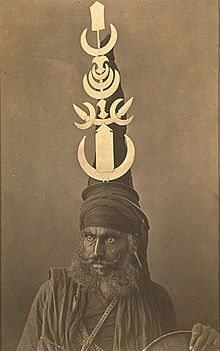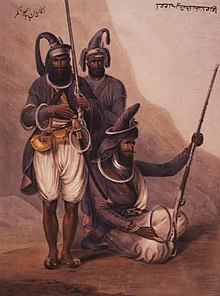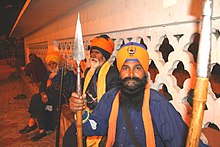Nihang: Difference between revisions
No edit summary Tags: Mobile edit Mobile web edit |
fixed ref(s) - CS1 errors: ISBN |
||
| Line 35: | Line 35: | ||
== Divisions == |
== Divisions == |
||
There are four main factions amongst the ''Nihangs'' of the modern-era, them namely being:<ref>{{Cite web |last=Judge |first=Paramjit S. |date=2021-10-20 |title=Nihang tradition is rich. Don't just view them through Singhu killing lens |url=https://theprint.in/opinion/nihang-tradition-is-rich-dont-just-view-them-through-singhu-killing-lens/753118/ |access-date=2022-09-02 |website=ThePrint |language=en-US |quote=There are four factions among the Nihangs: Budha Dal, Taruna Dal, Ranghreta Dal, and Bidhi Chand Taruna Dal. The last two are less prominent. Not much is talked about the Ranghreta Dal, and it consists of Nihangs exclusively belonging to the Mazhabi caste, whereas the Nihangs identified with Bidhi Chand, a devout follower of the sixth Guru of the Sikhs, are confined to village Sur Singh in Punjab’s Tarn Taran district to which he belonged.}}</ref><ref name=":0">{{Cite book |last1=Singh |first1=Pashaura |chapter-url=https://books.google.com/books?id=8I0NAwAAQBAJ&dq=bidhi+chand+dal&pg=PA372 |title=The Oxford Handbook of Sikh Studies |last2=Fenech |first2=Louis E. |publisher=Oxford Handbooks, OUP Oxford, 2014 |isbn= |
There are four main factions amongst the ''Nihangs'' of the modern-era, them namely being:<ref>{{Cite web |last=Judge |first=Paramjit S. |date=2021-10-20 |title=Nihang tradition is rich. Don't just view them through Singhu killing lens |url=https://theprint.in/opinion/nihang-tradition-is-rich-dont-just-view-them-through-singhu-killing-lens/753118/ |access-date=2022-09-02 |website=ThePrint |language=en-US |quote=There are four factions among the Nihangs: Budha Dal, Taruna Dal, Ranghreta Dal, and Bidhi Chand Taruna Dal. The last two are less prominent. Not much is talked about the Ranghreta Dal, and it consists of Nihangs exclusively belonging to the Mazhabi caste, whereas the Nihangs identified with Bidhi Chand, a devout follower of the sixth Guru of the Sikhs, are confined to village Sur Singh in Punjab’s Tarn Taran district to which he belonged.}}</ref><ref name=":0">{{Cite book |last1=Singh |first1=Pashaura |chapter-url=https://books.google.com/books?id=8I0NAwAAQBAJ&dq=bidhi+chand+dal&pg=PA372 |title=The Oxford Handbook of Sikh Studies |last2=Fenech |first2=Louis E. |publisher=Oxford Handbooks, OUP Oxford, 2014 |isbn=9780191004117 |pages=378 |chapter=Taksals, Akharas, and Nihang Deras|date=March 2014 }}</ref> |
||
=== Budha Dal === |
=== Budha Dal === |
||
Revision as of 23:51, 16 December 2022

The Nihang or Akali (lit. "the immortals") is an armed Sikh warrior order originating in the Indian subcontinent.[1] Nihang are believed to have originated either from Fateh Singh and the attire he wore[2] or from the "Akali" (lit. Army of the Immortal) started by Guru Hargobind.[3] Early Sikh military history was dominated by the Nihang, known for their victories where they were heavily outnumbered. Traditionally known for their bravery and ruthlessness in the battlefield, the Nihang once formed the irregular guerrilla squads of the armed forces of the Sikh Empire, the Sikh Khalsa Army.
Akali
The word Akali/akaali means timeless or immortal.[4]
Literally, one who belongs to Akaal (beyond Time). In other words, an Akaali is that person who is subject of none but God only. Conceptually speaking, the terms Akaali, Khalsa and Sikh are synonymous. The term Akaali was first used during the time of Guru Gobind Singh Sahib. The term Akaali became popular in the last decades of the eighteenth century.
The term came to be associated with “commitment, fearlessness, boldness, struggle, and justice.”[5]

Etymology
Nihang may come from the Persian word for a mythical sea creature (Persian: نهنگ).[6] The term owes its origin to Mughal historians, who compared the ferocity of the Akali with that of crocodiles.[7][8] The meaning of Akali in Sikhism however, is the immortal army of Akal (God).[9]
Origin
According to Pashaura Singh and Louis E. Fenech, there exists three main theories regarding the genesis of the Nihangs. These three theories are summarized below:[10]
- Began with the son of Guru Gobind Singh, Fateh Singh with his blue clothing and turban with the Guru prescribing this uniform for his warriors. (the one that most nihang singhs agree with)
- Second hypothesis claims that they originate from the disguise of Guru Gobind Singh when he escaped from Chamkaur in 1704 or 1705.
- Third theory postulates that they can be traced back to the garb of Akali Naina Singh of the Nishanwalia Misl.
Arms and attire

Traditional Nihang dress is known as Khalsa Swarupa. This comprises full attire of superelectric blue selected by Guru Gobind Singh after conflicts with Vazir Khan, the Mughal Governor of Sirhind,[11] several edged bracelets of iron round on each of their wrists (jangi kara) and quoits of steel (chakram) tiered in their lofty conical blue turbans, together with the either a dori kirpan (a open blade kirpan that is worn with a rope attached and was meant to be used as a quick access weapon) or a pesh kabaz - a predecessor to the modern kirpan. When fully armed a Nihang will also bear one or two swords (either the curved talwar or the straight khanda, or another type of sword like saif or sarohi on his right hip), a katar (dagger) on his left hip, a buckler made from buffalo-hide (dhal) on his back, a large chakram around his neck, and an iron chain. In times of war, arms worn on the Nihang's person would generally be reserved until the warrior lost the weapon he held, often a bow (kamaan) or spear (barcha). Armour consisted of sanjo or iron chainmail worn under an iron breastplate (char aina). Nihang war-shoes (jangi mozeh) were constructed of iron at the toe, making their pointed toes capable of inflicting cuts and stab wounds. Rarely a nihang might also be armed with a musket or a matchlock.[12][13]

The Nihang were particularly known for their high turbans (dastar bunga) and their extensive use of the chakram or war-quoit. Their turbans were often pointed at the top and outfitted with a chand torra or trident called astbhuja which could be used for stabbing in close-quarters. Other times, the turbans would be armed with a bagh naka (iron claw) and one or several chakram to slice at an opponent's eyes. These steel-reinforced turbans, it was said, afforded enough protection so that there was no need for any other form of headgear. Today, Nihang still wear miniature versions of five weapons (pancha shastra) in their turbans, namely the chakram, the khanda (sword), the karud (dagger), the kirpan, and the tir (arrow).

Divisions
There are four main factions amongst the Nihangs of the modern-era, them namely being:[14][10]
Budha Dal
Originally created for older members (over 40) by splitting the Dal Khalsa into two.[15]
Taruna (or Tarna) Dal
Originally created for younger members (under 40) by splitting the Dal Khalsa into two. The Taruna Dal was further divided in five jathas, each with 1300 to 2000 men and a separate drum and banner.[16]
Bidhi Chand Dal
Descend from lineage of Bidhi Chand, a contemporary warrior and companion of the Sikh Gurus.[17][18]
Ranghreta (or Rangreta) Dal
Prominent amongst Mazhabi Sikhs.
The latter two groups being much less prominent than the former two. Each Dal consists of both a mobile and stationary group. The mobile group of the Budha Dal, for example, is the Dalpanth. There has been incidents of conflict in the past between different groups of Akalis, even within the same faction.[19]
Use of intoxicants
Some Nihang groups consume cannabis or shaheedi degh (ਭੰਗ), purportedly to help in meditation.[20] [21][22] Sūkha parshaad (ਸੁੱਖਾ ਪ੍ਰਰਸਾਦ), "Dry-sweet", is the term Nihang use to refer to it. It was traditionally crushed and taken as a liquid, especially during festivals like Hola Mohalla. It is never smoked, as this practice is forbidden in Sikhism.[23]
In 2001, Jathedar Santa Singh, the leader of Budha Dal, along with 20 chiefs of Nihang sects, refused to accept the ban on consumption of shaheedi degh by the apex Sikh clergy - in order to preserve traditional Sikh practices.[24] According to a recent BBC article, "Traditionally they also drank shaheedi degh, an infusion of cannabis, to become closer with God"[25]
Nishan Sahib



The Nihangs carry the original view of Sikhism and carry the original Nishan Sahib being Navy/electric blue and bright yellow or basanti attire with a tegha, Dhal (shield) and katar. Yellow in Punjabi culture signifies sacrifice, revolt and honour while blue signifies courage, bravery and patriotism. Although in Punjab Blue is the colour of Khalsa and Yellow the colour of Kshatriyas the Gurus said that these are the colours of the casteless Khalsa.[citation needed]
See also
Notes
- ^ Brard, Gurnam (2007). East of Indus: My Memories of Old Punjab. Hemkunt Press. p. 185. ISBN 9788170103608.
- ^ Surjit, Gandhi (2007). History of Sikh Gurus Retold: 1606-1708 C.E, Volume 2 of History of Sikh Gurus Retold. Atlantic Publishers & Distributors. p. 999. ISBN 9788126908585.
- ^ Singh, Khushwant (1999). A History of the Sikhs Volume I:1469-1839. India: Oxford University Press. p. 215. ISBN 0-19-562643-5.
- ^ ਅਕਾਲੀ - akālī - अकाली ਵਿ- ਅਕਾਲ ਨਾਲ ਹੈ ਜਿਸ ਦਾ ਸੰਬੰਧ। ੨. ਸੰਗ੍ਯਾ- ਅਕਾਲ ਉਪਾਸਕ. ਵਾਹਗੁਰੂ ਜੀ ਕਾ ਖ਼ਾਲਸਾ.#ਕਮਲ ਜ੍ਯੋਂ ਮਾਯਾ ਜਲ ਵਿੱਚ ਹੈ ਅਲੇਪ ਸਦਾ#ਸਭ ਦਾ ਸਨੇਹੀ ਚਾਲ ਸਭ ਤੋਂ ਨਿਰਾਲੀ ਹੈ,#ਕਰਕੇ ਕਮਾਈ ਖਾਵੇ ਮੰਗਣਾ ਹਰਾਮ ਜਾਣੇ#ਭਾਣੇ ਵਿੱਚ ਵਿਪਦਾ ਨੂੰ ਮੰਨੋ ਖ਼ੁਸ਼ਹਾਲੀ ਹੈ,#ਸ੍ਵਾਰਥ ਤੋਂ ਬਿਨਾ ਗੁਰੁਦ੍ਵਾਰਿਆਂ ਦਾ ਚੌਕੀਦਾਰ#ਧਰਮ ਦੇ ਜੰਗ ਲਈ ਚੜ੍ਹੇ ਮੁਖ ਲਾਲੀ ਹੈ,#ਪੂਜੇ ਨੇ ਅਕਾਲ ਬਿਨਾ ਹੋਰ ਕੋਈ ਦੇਵੀ ਦੇਵ#ਸਿੱਖ ਦਸ਼ਮੇਸ਼ ਦਾ ਸੋ ਕਹੀਏ 'ਅਕਾਲੀ' ਹੈ.#੩. ਖ਼ਾਸ ਕਰਕੇ ਇਹ ਸ਼ਬਦ ਨਿਹੰਗ ਸਿੰਘਾਂ ਲਈ ਭੀ ਵਰਤਿਆ ਜਾਂਦਾ ਹੈ. ਦੇਖੋ, ਨਿਹੰਗ.
- ^ thesikhs.org. "All copyrights reserved to thesikhs.org".
- ^ Taba, David (2011). Iranian Character of The Armenian Language. p. 9.
- ^ ਨਿਹੰਗ - nihanga - निहंग ਫ਼ਾ. [نِہنگ] ਸੰਗ੍ਯਾ- ਖੜਗ. ਤਲਵਾਰ. "ਬਾਹਤ ਨਿਹੰਗ। ਉੱਠਤ ਫੁਲਿੰਗ." (ਸਲੋਹ) ਤਲਵਾਰ ਦੇ ਪ੍ਰਹਾਰ ਤੋਂ ਵਿਸ੍ਫੁਲਿੰਗ (ਚਿੰਗਾੜੇ) ਨਿਕਲਦੇ ਹਨ। ੨. ਕਲਮ. ਲੇਖਨੀ। ੩. ਘੜਿਆਲ. ਮਗਰਮੱਛ. (मकर मत्स्य) ਨਾਕੂ. Alligator. "ਜਨੁਕ ਲਹਿਰ ਦਰਯਾਵ ਤੇ ਨਿਕਸ੍ਯੋ ਬਡੋ ਨਿਹੰਗ." (ਚਰਿਤ੍ਰ ੨੧੭) ੪. ਡਿੰਗ- ਘੋੜਾ. ਅਸ਼੍ਵ. ਤੁਰੰਗ. "ਬਿਚਰੇ ਨਿਹੰਗ। ਜੈਸੇ ਪਿਲੰਗ." (ਵਿਚਿਤ੍ਰ) ਚਿਤ੍ਰੇ ਵਾਂਙ ਛਾਲਾਂ ਮਾਰਦੇ ਘੋੜੇ ਵਿਚਰੇ। ੫. ਸੰ. निः शङ्क ਨਿਹਸ਼ੰਕ. ਵਿ- ਜਿਸ ਨੂੰ ਮੋਤ ਦੀ ਚਿੰਤਾ ਨਹੀਂ. ਬਹਾਦੁਰ. ਦਿਲੇਰ. "ਨਿਰਭਉ ਹੋਇਓ ਭਇਆ ਨਿਹੰਗਾ." (ਆਸਾ ਮਃ ੫) "ਪਹਿਲਾ ਦਲਾਂ ਮਿਲੰਦਿਆਂ ਭੇੜ ਪਿਆ ਨਿਹੰਗਾ." (ਚੰਡੀ ੩) ੬. ਸੰ. निः सङ्ग- ਨਿਹਸੰਗ. ਨਿਰਲੇਪ. ਆਤਮਗ੍ਯਾਨੀ. ਦੁੰਦ (ਦ੍ਵੰਦ੍ਵ) ਦਾ ਤਿਆਗੀ. "ਨਿਹੰਗ ਕਹਾਵੈ ਸੋ ਪੁਰਖ ਦੁਖ ਸੁਖ ਮੰਨੇ ਨ ਅੰਗ." (ਪ੍ਰਾਪੰਪ੍ਰ) "ਮੁੱਲਾ ਬ੍ਰਾਹਮਣ ਨਾ ਬੁਝੈ ਬੁਝੈ ਫਕਰ ਨਿਹੰਗ." (ਮਗੋ) ੭. ਸਿੰਘਾਂ ਦਾ ਇੱਕ ਫਿਰਕਾ, ਜੋ ਸੀਸ ਪੁਰ ਫਰਹਰੇ ਵਾਲਾ ਉੱਚਾ ਦਮਾਲਾ, ਚਕ੍ਰ, ਤੋੜਾ, ਖੰਡਾ, ਕ੍ਰਿਪਾਨ, ਗਜਗਾਹ ਆਦਿਕ ਸ਼ਸਤ੍ਰ ਅਰ ਨੀਲਾ ਬਾਣਾ ਪਹਿਨਦਾ ਹੈ, ਨਿਹੰਗ ਸਿੰਘ ਮਰਣ ਦੀ ਸ਼ੰਕਾ ਤਿਆਗਕੇ ਹਰਵੇਲੇ ਸ਼ਹੀਦੀ ਪਾਉਣ ਨੂੰ ਤਿਆਰ ਤੇ ਮਾਇਆ ਤੋਂ ਨਿਰਲੇਪ ਰਹਿਂਦਾ ਹੈ, ਜਿਸ ਲਈ ਇਹ ਨਾਮ ਹੈ.#ਬਹੁਤ ਸਿੰਘਾਂ ਤੋਂ ਸੁਣੀਦਾ ਹੈ ਕਿ ਇੱਕ ਵਾਰ ਸਾਹਿਬਜ਼ਾਦਾ ਫਤੇ ਸਿੰਘ ਜੀ ਵਿਲਾਸ ਕਰਦੇਹੋਏ ਸੀਸ ਤੇ ਦਮਾਲਾ ਸਜਾਕੇ ਦਸ਼ਮੇਸ਼ ਦੇ ਹਜੂਰ ਆਏ, ਜਿਸ ਪੁਰ ਪਿਤਾ ਜੀ ਨੇ ਫਰਮਾਇਆ ਕਿ ਇਸ ਬਾਣੇ ਦਾ ਇੱਕ ਨਿਹੰਗਪੰਥ ਹੋਵੇਗਾ.#ਕਈ ਆਖਦੇ ਹਨ ਕਿ ਜਦ ਕਲਗੀਧਰ ਨੇ ਉੱਚ- ਪੀਰ ਵਾਲਾ ਨੀਲਾ ਬਾਣਾ ਅਗਨੀ ਵਿੱਚ ਸਾੜਿਆ, ਉਸ ਸਮੇਂ ਇੱਕ ਲੀਰ ਕਟਾਰ ਨਾਲ ਬੰਨ੍ਹੀ, ਜਿਸ ਤੋਂ ਨੀਲਾਂਬਰੀ ਸੰਪ੍ਰਦਾਯ ਚੱਲੀ, ਜੇਹਾ ਕਿ ਭਾਈ ਸੰਤੋਖ ਸਿੰਘ ਜੀ ਲਿਖਦੇ ਹਨ- (ਗੁਪ੍ਰਸੂ)#ਭਾਈ ਸੰਤੋਖ ਸਿੰਘ ਜੀ ਇਹ ਭੀ ਲਿਖਦੇ ਹਨ ਕਿ ਸ਼੍ਰੀ ਗੁਰੂ ਗੋਬਿੰਦ ਸਿੰਘ ਜੀ ਨੇ ਭਾਈ ਮਾਨ ਸਿੰਘ ਨੂੰ ਵਰ ਦਿੱਤਾ ਕਿ ਤੇਰਾ ਨਿਹੰਗ ਪੰਥ ਚੱਲੇਗਾ, ਯਥਾ-#"ਹੈ ਪ੍ਰਸੰਨ ਬਰ ਦੇਵਤ ਜੋਵੈ।#ਪੰਥ ਖਾਲਸੇ ਮੇ ਤਵ ਹੋਵੈ।#ਤੁਝ ਸਮ ਬੇਖ¹ ਸੁਭਾਉ ਬਿਸਾਲੀ।#ਨਾਮ ਨਿਹੰਗ ਅਨੇਕ ਅਕਾਲੀ." (ਗੁਪ੍ਰਸੂ)#ਬਹੁਤ ਨਿਹੰਗ ਸਿੰਘ ਇਹ ਭੀ ਆਖਦੇ ਹਨ ਕਿ ਸ਼੍ਰੀ ਗੁਰੂ ਗੋਬਿੰਦ ਸਿੰਘ ਸ੍ਵਾਮੀ ਨੇ ਸਿੰਘਾਂ ਦੇ ਸੀਸ ਦਮਾਲੇ ਦਾ ਫਂਰਹਰਾ ਨਿਸ਼ਾਨ ਦਾ ਚਿੰਨ੍ਹ ਥਾਪਿਆ, ਪਰ ਗੁਰੁਪੁਰ- ਨਿਵਾਸੀ ਵ੍ਰਿੱਧ ਵਿਵੇਕਾ ਸਿੰਘ ਦੀ ਅਮ੍ਰਿਤਸਰੀ ਦੇ ਕਥਨ ਅਨੁਸਾਰ ਬਾਬਾ ਨੈਣਾ ਸਿੰਘ (ਨਾਰਾਇਣ ਸਿੰਘ) ਨੇ ਸਭ ਤੋਂ ਪਹਿਲਾਂ ਫ਼ੌਜ ਦੇ ਨਿਸ਼ਾਨਚੀ ਦੇ ਸਿਰ ਉੱਪਰ ਦਮਾਲਾ ਸਜਾਕੇ ਨਿਸ਼ਾਨ ਦਾ ਫਰਹਰਾ ਝੁਲਾਇਆ, ਤਾਕਿ ਉਹ ਸਭ ਤੋਂ ਅੱਗੇ ਨਿਸ਼ਾਨ ਦੀ ਥਾਂ ਭੀ ਹੋਵੇ ਅਤੇ ਹੱਥ ਵੇਹਲੇ ਹੋਣ ਕਰਕੇ ਸ਼ਸਤ੍ਰ ਭੀ ਚਲਾ ਸਕੇ.#ਬਾਬਾ ਨੈਣਾ ਸਿੰਘ ਦਾ ਚਾਟੜਾ ਅਕਾਲੀ ਫੂਲਾ ਸਿੰਘ ਸਿੱਖ ਦਲ ਵਿੱਚ ਪ੍ਰਸਿੱਧ ਸੈਨਾਪਤੀ ਹੋਇਆ ਹੈ. ਨਿਹੰਗ ਸਿੰਘ ਅਕਾਲ ਦੇ ਉਪਾਸਕ ਅਤੇ ਅਕਾਲ! ਅਕਾਲ! ਜਪਦੇ ਹਨ, ਇਸ ਕਾਰਣ "ਅਕਾਲੀ" ਨਾਮ ਭੀ ਮਸ਼ਹੂਰ ਹੋ ਗਿਆ ਹੈ. ਦੇਖੋ, ਅਕਾਲੀ.#ਨਿਹਾਲ ਸਿੰਘ ਜੀ ਨਿਹੰਗਾਂ ਬਾਬਤ ਦਸ਼ਮੇਸ਼ ਦਾ ਫ਼ਰਮਾਨ ਲਿਖਦੇ ਹਨ-#ਧਰ੍ਮ ਦੇ ਧੁਰੰਧਰ ਉਦਾਰਤਾ ਕੇ ਧਾਰਾਧਰ#ਭੋਲੇ ਭਾਲ ਭ੍ਰਾਜਤੇ ਝਕੋਲ ਪ੍ਰੇਮ ਰੰਦ ਮੈ,#ਸਰ੍ਬਲੋਹ ਪ੍ਯਾਰੇ ਅਰ੍ਬ ਖਰ੍ਬ ਲੌ ਨ ਦਰ੍ਬ ਬੰਧ#ਨੈਕ ਹੂੰ ਨ ਗਰ੍ਬ ਪੁੰਨ ਪਰ੍ਬ ਯਾਕੇ ਸੰਗ ਮੈ,#ਸਾਜਕੈ ਸੁਬਾਨੋ ਸੂਰ ਗਾਜਕੈ ਮ੍ਰਿਗੇਂਦ੍ਰ ਭੂਰਿ#ਭਾਜਕੈ ਗਨੀਮ ਕੋ ਬਿਦਾਰੈਂ ਜੋਰ ਜੰਗ ਮੈ,#ਮੋਦ ਕੇ ਤਰੰਗ ਮੈ ਉਮੰਗ ਕੈ ਉਤੰਗ ਪੰਥ#ਲੋਕ ਦੰਗ ਕੈਬੇ ਕੋ ਸੁ ਕੀਨੇ ਏ ਨਿਹੰਗ ਮੈ.
- ^ फ़ा. [نِہنگ] संग्या- खड़ग. तलवार. "बाहत निहंग। उॱठत फुलिंग."(सलोह) तलवार दे प्रहार तों विस्फुलिंग (चिंगाड़े) निकलदे हन। २. कलम. लेखनी। ३. घड़िआल. मगरमॱछ. (मकर मत्स्य) नाकू. Alligator. "जनुक लहिर दरयाव ते निकस्यो बडो निहंग." (चरित्र २१७) ४. डिंग- घोड़ा. अश्व. तुरंग. "बिचरे निहंग। जैसे पिलंग." (विचित्र) चित्रे वांङ छालां मारदे घोड़े विचरे। ५. सं. निः शङ्क निहशंक. वि- जिस नूं मोत दी चिंता नहीं. बहादुर. दिलेर. "निरभउ होइओ भइआ निहंगा." (आसा मः ५) "पहिला दलां मिलंदिआं भेड़ पिआ निहंगा." (चंडी ३) ६. सं. निः सङ्ग- निहसंग. निरलेप. आतमग्यानी. दुंद (द्वंद्व) दा तिआगी. "निहंग कहावै सो पुरख दुख सुख मंने न अंग." (प्रापंप्र) "मुॱला ब्राहमण ना बुझै बुझै फकर निहंग." (मगो) ७. सिंघां दा इॱक फिरका, जो सीस पुर फरहरे वाला उॱचा दमाला, चक्र, तोड़ा, खंडा, क्रिपान, गजगाह आदिक शसत्र अर नीला बाणा पहिनदा है, निहंग सिंघ मरण दी शंका तिआगके हरवेले शहीदी पाउण नूं तिआर ते माइआ तों निरलेप रहिंदा है, जिस लई इह नाम है.#बहुत सिंघां तों सुणीदा है कि इॱक वार साहिबज़ादा फते सिंघ जी विलास करदेहोए सीस ते दमाला सजाके दशमेश दे हजूर आए, जिस पुर पिता जी ने फरमाइआ कि इस बाणे दा इॱक निहंगपंथ होवेगा.#कई आखदेहन कि जद कलगीधर ने उॱच- पीर वाला नीला बाणा अगनी विॱच साड़िआ, उस समें इॱक लीर कटार नाल बंन्ही, जिस तों नीलांबरी संप्रदाय चॱली, जेहा कि भाई संतोख सिंघ जी लिखदे हन- (गुप्रसू)#भाई संतोख सिंघ जी इह भी लिखदे हन कि श्री गुरू गोबिंद सिंघ जी ने भाई मान सिंघ नूं वर दिॱता कि तेरा निहंग पंथ चॱलेगा, यथा-#"है प्रसंन बर देवत जोवै।#पंथ खालसे मे तव होवै।#तुझ सम बेख¹ सुभाउ बिसाली।#नाम निहंग अनेक अकाली." (गुप्रसू)#बहुत निहंग सिंघ इह भी आखदे हन कि श्री गुरू गोबिंद सिंघ स्वामी ने सिंघां दे सीस दमाले दा फंरहरा निशान दा चिंन्ह थापिआ, पर गुरुपुर- निवासी व्रिॱध विवेका सिंघ दी अम्रितसरी दे कथन अनुसार बाबा नैणा सिंघ (नाराइण सिंघ) ने सभ तों पहिलां फ़ौज दे निशानची दे सिर उॱपर दमाला सजाके निशान दा फरहरा झुलाइआ, ताकि उह सभ तों अॱगे निशान दी थां भी होवे अते हॱथ वेहले होण करके शसत्र भी चला सके.#बाबा नैणा सिंघ दा चाटड़ा अकाली फूला सिंघ सिॱख दल विॱच प्रसिॱध सैनापती होइआ है. निहंग सिंघ अकाल दे उपासक अते अकाल! अकाल! जपदे हन, इस कारण "अकाली" नाम भी मशहूर हो गिआ है. देखो, अकाली.#निहाल सिंघ जी निहंगां बाबत दशमेश दा फ़रमान लिखदे हन-#धर्म देधुरंधर उदारता के धाराधर#भोले भाल भ्राजते झकोल प्रेम रंद मै,#सर्बलोह प्यारे अर्ब खर्ब लौ न दर्ब बंध#नैक हूं न गर्ब पुंन पर्ब याके संग मै,#साजकै सुबानो सूर गाजकै म्रिगेंद्र भूरि#भाजकै गनीम को बिदारैं जोर जंग मै,#मोद के तरंग मै उमंग कै उतंग पंथ#लोक दंग कैबे को सु कीने ए निहंग मै.
- ^ Singh, Khushwant (1999). A History of the Sikhs Voghzlume I:1469-1839. India: Oxford University Press. p. 215. ISBN 0-19-562643-5.
- ^ a b Singh, Pashaura; Fenech, Louis E. (March 2014). "Taksals, Akharas, and Nihang Deras". The Oxford Handbook of Sikh Studies. Oxford Handbooks, OUP Oxford, 2014. p. 378. ISBN 9780191004117.
- ^ Macauliffe, Max Arthur (1909). The Sikh Religion: Its Gurus, Sacred Writings and Authors Volume 5. United Kingdom: Cambridge University Press. p. 210. ISBN 978-1-108-05547-5.
- ^ https://www.outlookindia.com/website/story/india-news-nihangs-all-you-need-to-know-about-them/398285
- ^ https://www.sikhiwiki.org/index.php/Weapons_of_Guru_Gobind_Singh
- ^ Judge, Paramjit S. (2021-10-20). "Nihang tradition is rich. Don't just view them through Singhu killing lens". ThePrint. Retrieved 2022-09-02.
There are four factions among the Nihangs: Budha Dal, Taruna Dal, Ranghreta Dal, and Bidhi Chand Taruna Dal. The last two are less prominent. Not much is talked about the Ranghreta Dal, and it consists of Nihangs exclusively belonging to the Mazhabi caste, whereas the Nihangs identified with Bidhi Chand, a devout follower of the sixth Guru of the Sikhs, are confined to village Sur Singh in Punjab's Tarn Taran district to which he belonged.
- ^ Singha, H. S. (2005). Sikh Studies, Book 6. Hemkunt Press. p. 37. ISBN 8170102588.
- ^ Narang, K. S.; Gupta, H. R. (1969). History of Punjab: 1500 - 1558. p. 216. Retrieved 15 July 2010.
- ^ "Home - The Nihang Singhs". www.nihangsinghs.de. Retrieved 2022-09-02.
- ^ "Baba Bidhi Chand Dal" (PDF). www.deutsches-informationszentrum-sikhreligion.de (in Punjabi). Retrieved 2022-09-02.
- ^ "Budha Dal Factions Clash". panthic.org. Retrieved 2022-09-02.
- ^ Richard Beck, David Worden (2002). Gcse Religious Studies for Aqa. p. 64. ISBN 0-435-30692-8.
- ^ Hola Mohalla: United colours of celebrations,
- ^ "Mad About Words". Telegraphindia.com. 2004-01-03. Retrieved 2014-01-04.
- ^ "UCSM.ac.uk". Philtar.ucsm.ac.uk. Archived from the original on 2010-10-16. Retrieved 2014-01-04.
- ^ Nihangs ‘not to accept’ ban on shaheedi degh. The Tribune. March 26, 2001.
- ^ Hegarty, Stephanie (2011-10-29). "BBC News - The only living master of a dying martial art". Bbc.co.uk. Retrieved 2014-01-04.
References
- Dasam Granth , The Dasam Granth website
- Book review of the Nihang book The Beloved Forces of the Guru
- "Tribes and Castes of Punjab and N.W. Frontier Province" by H.A. Rose (1892)
- Bhai Sahib Amrit Pal Singh 'Amrit' has presented well-researched articles on Nihangs on his website
- www.Budhadal.com
External links
- Sikh Photography Images of Nihangs by photographer Charles Meacham
- Sarbloh.info
- Nihangsingh.org
- Nihang SGPC
- Photography of the daily lives of the Nihang Singhs of Punjab by photographer Nick Fleming
